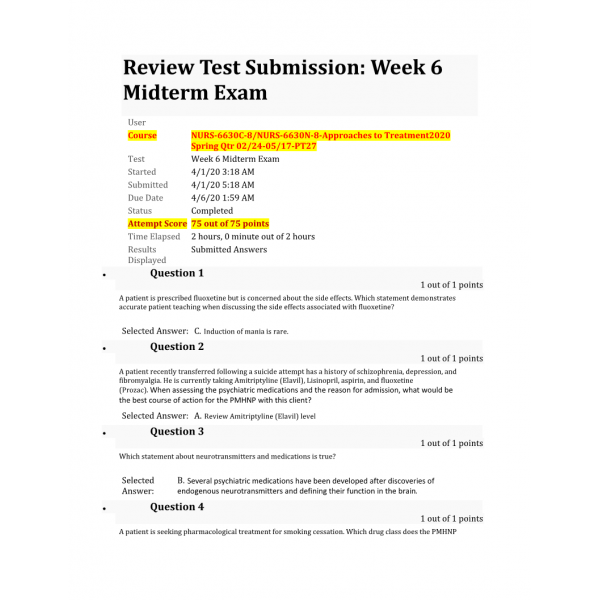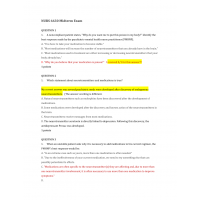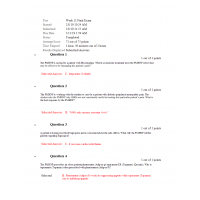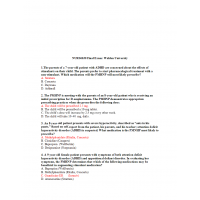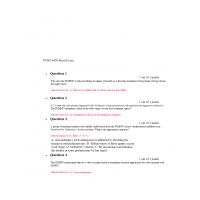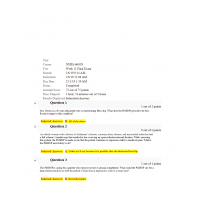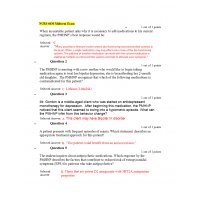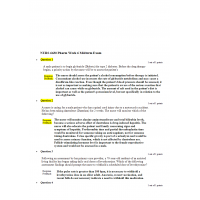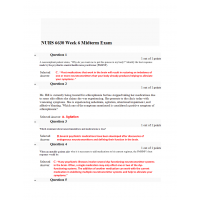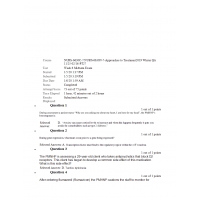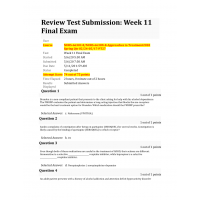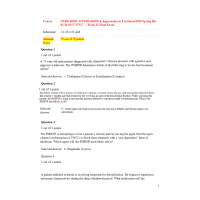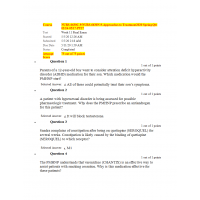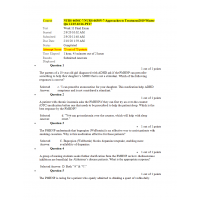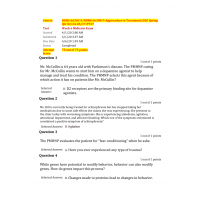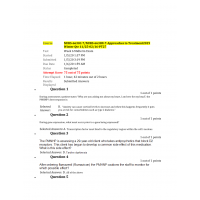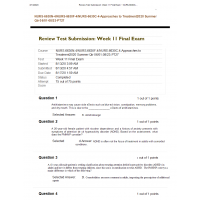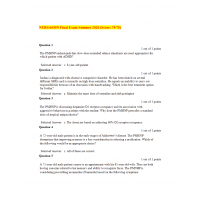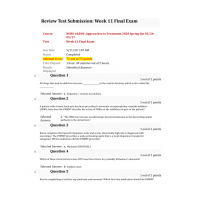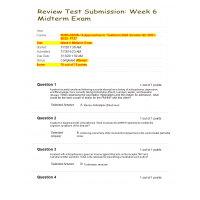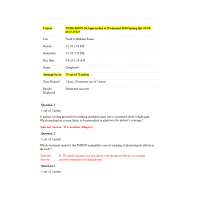NURS 6630 Week 6 Midterm Exam
NURS-6630C-8/NURS-6630N-8-Approaches to Treatment
1. A patient is prescribed fluoxetine but is concerned about the side effects. Which statement demonstrates accurate patient teaching when discussing the side effects associated with fluoxetine?
2. A patient recently transferred following a suicide attempt has a history of schizophrenia, depression, and fibromyalgia. He is currently taking Amitriptyline (Elavil), Lisinopril, aspirin, and fluoxetine (Prozac). When assessing the psychiatric medications and the reason for admission, what would be the best course of action for the PMHNP with this client?
3. Which statement about neurotransmitters and medications is true?
4. A patient is seeking pharmacological treatment for smoking cessation. Which drug class does the PMHNP prescribe to the patient?
5. A 25-year-old female patient is being prescribed milnacipran to treat fibromyalgia and expresses concern regarding “how she will feel and look” from taking the medicine. Which statement correctly describes the side effects as a result of taking this medication?
6. Which statement made by the patient suggests the patient will need to be treated with antipsychotics that target paranoid psychosis?
7. The PMHNP is caring for a patient with the s genotype of SERT. What does the PMHNP understand regarding this patient’s response to selective serotonin reuptake inhibitor (SSRI)/SNRI treatment?
8. A patient who is prescribed MAO inhibitors asks about whether he can continue taking pseudoephedrine to relieve his congestion. Which response by the PMHNP indicates proper understanding of drug-drug interactions?
9. Mrs. Schwartzman is a 52-year-old patient with schizophrenia and no established history of depression. When meeting with the PMHNP, she presents with apathy and withdrawn social behavior, and she reports a loss of joy from enjoyable activities. What does the PMHNP infer from this encounter with the patient?
10. The PMHNP understands that the potential of alcohol abuse in the anxious client is higher for the following reasons:
11. A 51-year-old female patient presents with symptoms of depression, including lack of motivation and difficulty sleeping. What risk factors would increase her vulnerability for a diagnosis of depression?
12. A patient who was diagnosed with bipolar disorder without mania, asks the PMHNP why he is being prescribed a mood stabilizer. What is the appropriate response?
13. After ordering flumazenil (Rumazicon) the PMHNP cautions the staff to monitor for which possible effect?
14. When an unstable patient asks why it is necessary to add medications to his current regimen, the PMHNP’s best response would be:
15. The PMNHP is assessing a 29-year-old client who takes antipsychotics that block D2 receptors. This client has begun to develop a common side effect of this medication. What is this side effect?
16. The nurse education knows that teaching was effective when one of the students compares fluvoxamine to sertraline and notes which of the following similarities?
17. A patient was diagnosed with GAD 4 weeks ago and was placed on Clonazepam (klonopin) twice a day and citalopram (citalopram (celexa)) once daily. When he asks the PMHNP why it is necessary to wean him off of the Clonazepam (klonopin) the best response is:
18. Mr. Gordon is a middle-aged client who was started on antidepressant monotherapy for depression. After beginning this medication, the PMHNP noticed that this client seemed to swing into a hypomanic episode. What can the PMHNP infer from this behavior change?
19. It is important for the PMHNP to recognize differences in pharmacokinetics to safely prescribe and monitor medications. Which of the following statements does the competent PMHNP identify as true?
20. The PMHNP is meeting with a new mother who would like to begin taking medication again to treat her bipolar depression; she is breastfeeding her 2-month old daughter. The PMHNP recognizes that which of the following medications is contraindicated for this client?
21. The PMHNP is caring for a new patient who has been transferred from another office. When meeting with the new patient, the patient reports, “I feel like I am improving with the stabilizers.” The PMHNP immediately recognizes that the patient is describing which kind of drug?
22. A patient is diagnosed with bipolar disorder and is currently taking carbamazepine (Tegretol), aripiprazole (Abilify), and melatonin. The PMHNP has just written an order to discontinue the carbamazepine (Tegretol) for drug-induced thrombocytopenia. The PMHNP is aware that his next best action is to:
23. A patient is prescribed sertraline to treat panic disorder. Knowing that sertraline can initially cause anxiety or insomnia, what should the PMHNP do?
24. The PMHNP evaluates the patient for “fear conditioning” when he asks:
25. The PMHNP spends a session with a client and notices behaviors correlating with a potential manic episode. All of the following are possible manic symptoms the PMHNP could observe except:
26. A patient diagnosed with PTSD is prescribed propranolol (Inderal) and the PMHNP understands that he was prescribed this medication for what purpose:
27. The PMHNP is caring for four patients. Which patient statement indicates that benzodiazepines would be beneficial?
28. The PMHNP is meeting with a new mother who would like to begin taking medication again to treat her bipolar depression; she is breastfeeding her 2-month old daughter. The PMHNP recognizes that which of the following medications is contraindicated for this patient?
29. What characteristics do the nicotinic, cholinergic, serotonin 3, and glycine receptors all have in common?
30. When completing this exam, did you comply with Walden University’s Code of Conduct including the expectations for academic integrity?
31. The PMHNP is considering prescribing a 49-year-old male clozapine (Clozaril) to treat his schizophrenia and suicidal ideations. The PMHNP is aware that which factor may impact the dose needed to effectively treat his condition:
32. A nursing student is seeking clarification on the use of anticonvulsants to treat bipolar depression and is unclear about which anticonvulsants have the most effective outcomes in treating bipolar depression. Which of the following anticonvulsants is NOT used for treating bipolar depression?
33. A nurse overhears that a client has failed monotherapy with an SSRI and an SNRI. She also learns that the client has failed dual SSRI + SNRI therapy. The nurse approaches the PMHNP and asks what treatment options should be considered in this treatment resistant client. The PMHNP tells the nurse that she will treat the client with the following regimen.
34. Mr. Ruby is a 33-year-old single father who is requesting pharmacological intervention to treat his fibromyalgia. The PMHNP sees in the medical chart that he has a recent diagnosis of arrhythmia and a BMI of 29. During his assessment, the PMHNP learns that Mr. Ruby works 40–50 hours a week as a contractor and “manages his stress” by smoking 3–4 cigarettes a day and having 8–10 drinks of alcohol each week. Why would duloxetine be contraindicated for Mr. Ruby?
35. During assessment a patient states “Why are you asking me about my heart, I am here for my head”, the PMHNP’s best response is:
36. A 45 year old female client with allergic rhinitis and normal blood pressure has had no reduction in depressive symptoms after trying bupropion, paroxetine, and venlafaxine. What precautions are needed when considering phenelzine in treating her depression?
37. A nursing student is seeking clarification on the use of anticonvulsants to treat depression and is unclear about most effective outcomes. Which of the following agents does the PMHNP convey as having uncertain outcomes?
38. Mr. Gordon is a middle-aged patient who is taking antipsychotics. When meeting with the PMHNP, he reports positive responses to the medication, stating, “I really feel as though the effects of my depression are going away.” Which receptor action in antipsychotic medications is believed to be the most beneficial in producing the effects described by Mr. Gordon?
39. The PMHNP understands that which mechanism contributes to a worse tolerability profile for patients taking tricyclic antidepressants (TCAs)?
40. A patient is being prescribed a sedating antidepressant, but is concerned about weight gain. Which medication is most likely to be prescribed to addresses the patient’s concerns?
41. Ms. Hill is currently being treated for schizophrenia but has stopped taking her medications due to some side effects she claims she was experiencing. She presents to the clinic today with worsening symptoms. She is experiencing anhedonia, agitation, attentional impairment, and affective blunting. Which one of the symptoms mentioned is considered a positive symptom of schizophrenia?
42. There are a number of endocrine reactions that accompany fear. A quick boost of cortisol may enhance survival when encountering a real but short-term threat. However, chronic elevations in cortisol can lead to increased medical comorbidities. Which of the following medical conditions may be related to these persistent cortisol elevations?
43. Ms. Skidmore presents for a follow-up appointment after being prescribed phenelzine (Nardil), and reports “I take my 45 mg pill, three times a day, just like I’m supposed to.” What does the PMHNP understand about this patient?
44. Ms. Ryerson is a 28-year-old patient with a mood disorder. She recently requested to transfer to a new PMHNP, after not getting along well with her previous provider. The new PHMNP is reviewing Ms. Ryerson’s medical chart prior to their first appointment. Upon review, the PMHNP sees that the former provider last documented “patient had rapid poop out.” What does the PMHNP infer about the patient’s prescription based on this documentation?
45. Ms. Harlow is a 42-year-old patient who is prescribed a drug that acts on ionotropic receptors. She is curious about the effects of the drug and how it will act on her symptoms. Which statement made by the PMHNP demonstrates proper understanding of Ms. Harlow’s prescription?
46. Fluoxetine (Prozac) has been prescribed for a client with depression. Which of the following statements is true regarding the action of this medication?
47. Mrs. Trevor is a 44-year-old patient who does not have a diagnosis of schizophrenia but occasionally reports symptoms of psychosis, followed by severe fatigue. Mrs. Trevor inquires about the use of amphetamines to help with her energy levels. Which response made by the PMHNP is most appropriate?
48. A nurse overhears that a patient has failed single therapy with an SSRI and SNRI. She also learns that the patient has been on dual SSRI/SNRI therapy without adequate symptom control. She approaches the PMHNP and asks what the next treatment option could be in this seemingly treatment-resistant patient. The PMHNP tells the nurse she will treat the patient with the following regimen:
49. Though medications have the ability to target neurotransmitter release into the synapse by the presynaptic neuron it is not always necessary. The PMHNP understands that this is because:
50. Ms. Boeckh is a 42-year-old client who is taking an antidepressant therapy. The PMHNP understands that this medication can have substantial food interactions that can cause Ms. Boeckh to develop a hypertensive crisis. Which antidepressant class is Ms. Boeckh’s medication in?
51. The PMHNP is caring for a patient who is taking antipsychotics heard the psychiatrist tell the patient that the patient would be placed on a different antipsychotic agent called an atypical antipsychotic. What neurotransmitters will this new medication work on?
52. Mrs. Schwartzman is a 52-year-old client with schizophrenia and no established history of depression. When meeting with the PMHNP, she presents with apathy and withdrawn social behavior, and she reports a loss of joy from enjoyable activities since starting her new medication. What does the PMHNP infer from this encounter with the client?
53. A patient is diagnosed with schizophrenia. What increases the patient’s potential to mediate the cognitive symptoms of the disease?
54. Why is the cytochrome P450 enzyme system of significance to the PMHNP?
55. What is accurate about the clinical description of psychosis?
56. The PMHNP recognizes that which patient would be contraindicated for antidepressant monotherapy?
57. The PMHNP is assessing a patient in the psychiatric emergency room. The patient tells the PMHNP that he does not understand why his depression has not lifted after being on four different antidepressants over the course of a year. Which of the following symptoms can be residual symptoms for patients who do not achieve remission with major depressive disorder?
58. A patient presents with frequent episodes of mania. Which statement describes an appropriate treatment approach for this patient?
59. As it relates to G-protein linked receptors, what does the PMHNP understand about medications that are used in practice?
60. Ms. Boeckh is a 42-year-old patient with major depression. The PMHNP understands that which action of norepinephrine will affect Ms. Boeckh’s serotonin levels?
61. A client is prescribed fluoxetine but is concerned about side effects. Which statement demonstrates accurate client teaching when discussing the side effects associated with fluoxetine?
62. Mr. McCullin is 64 years old with Parkinson’s disease. The PMHNP caring for Mr. McCullin wants to start him on a dopamine agonist to help manage and treat his condition. The PHMNP selects this agent because of which action it has on patients like Mr. McCullin?
63. The PMHNP is assessing a client in the emergency room. The client shares that he has been on lithium for many years. What blood test does the PMHNP order?
64. Which statement made by the PMHNP exemplifies correct teaching of physiological effects in the body?
65. A client who was diagnosed with bipolar disorder without mania, asks the PMHNP why he is being prescribed a mood stabilizer. What is the appropriate response?
66. A patient with schizophrenia is given an inverse agonist that acts on the receptor 5HT and neurotransmitter serotonin. What is the rationale for prescribing a medication such as this?
67. A patient who was prescribed an MAO inhibitor is learning about dietary modifications. Which statement made by the PMHNP demonstrates proper teaching of the food-drug interactions for MAO inhibitors?
68. A patient is prescribed 50 mg of desvenlafaxine to take every other day for major depressive disorder. What does the PMHNP understand about this patient?
69. The PMHNP is caring for a patient with schizophrenia and is considering a variety of treatment approaches. The PHMNP selects a viable treatment that is consistent with the “dopamine hypothesis of schizophrenia.” What action does the PMHNP anticipate this treatment having on the patient?
70. The PMHNP is caring for several patients who present with various symptoms and health issues. For which patient does the PMHNP prescribe pregabalin (Lyrica)?
71. Fluoxetine (Prozac) has been prescribed for a patient. Which of the following statements is true regarding the action of this medication?
72. During gene expression, what must occur prior to a gene being expressed?
73. While genes have potential to modify behavior, behavior can also modify genes. How do genes impact this process?
74. The student inquires about antipsychotic medications. Which response by the PMHNP describes the factors that contribute to reduced risk of extrapyramidal symptoms (EPS) for patients who take antipsychotics?
75. Mr. Gutier is 72 years old with anxiety and depressive symptoms. His PMHNP is prescribing lorazepam (Ativan). What does the PMHNP understand regarding this prescription?
76. A noncompliant patient states, “Why do you want me to put this poison in my body?” Identify the best response made by the psychiatric-mental health nurse practitioner (PMHNP).
| Institution & Term/Date | |
| Term/Date | Walden University |
NURS 6630C - NURS 6630N Midterm Exam 3 (75 out of 75)
- Product Code: 2020
- Availability: In Stock
-
$30.00
Related Products
Tags: NURS 6630

